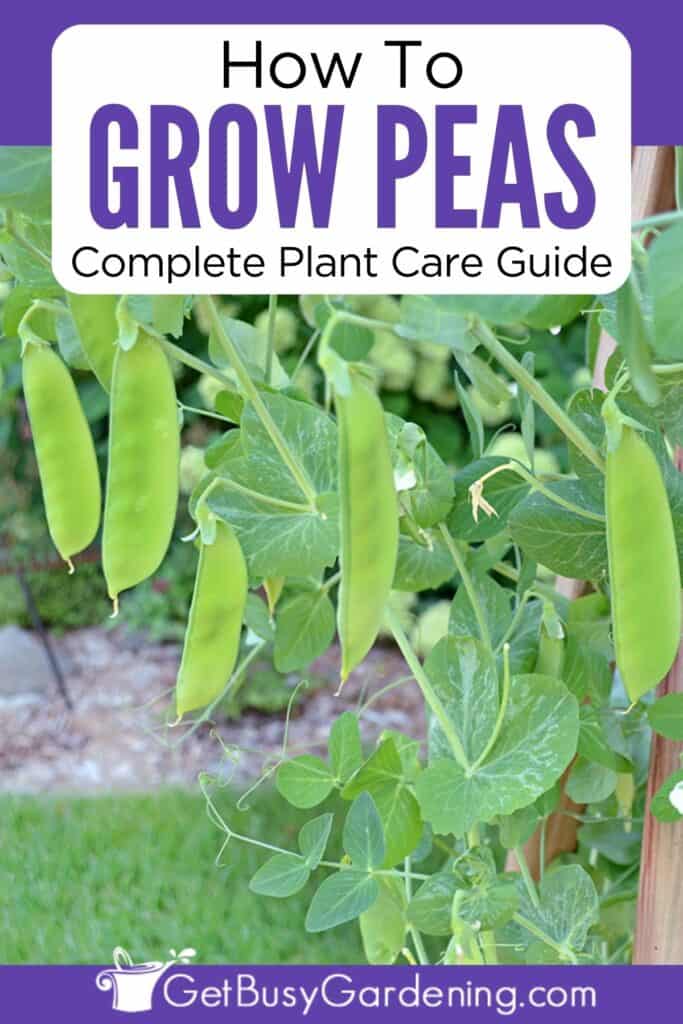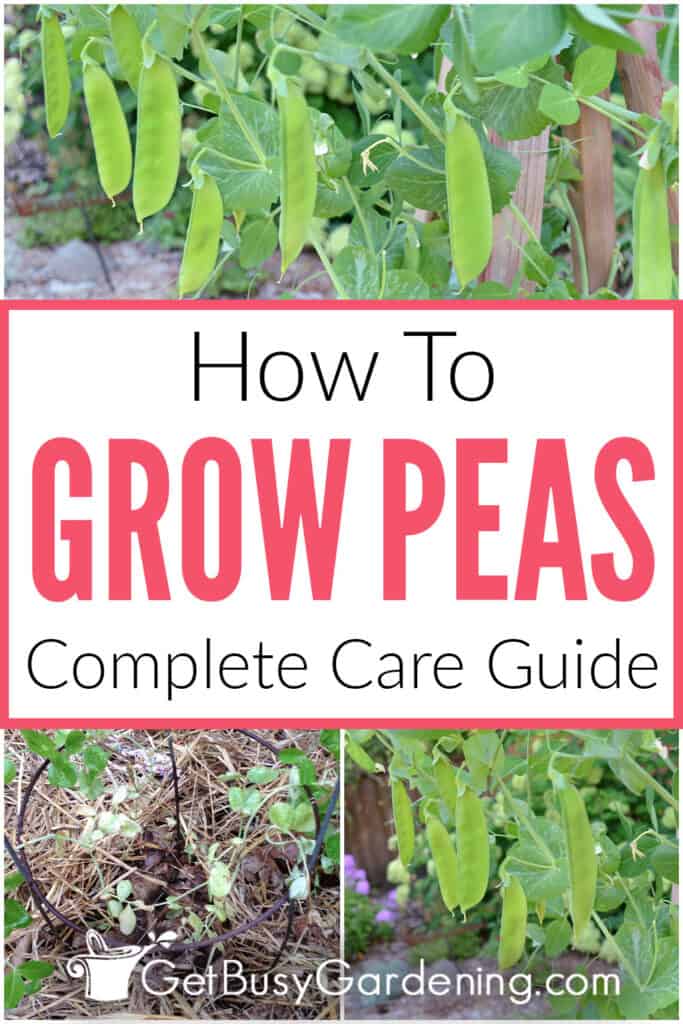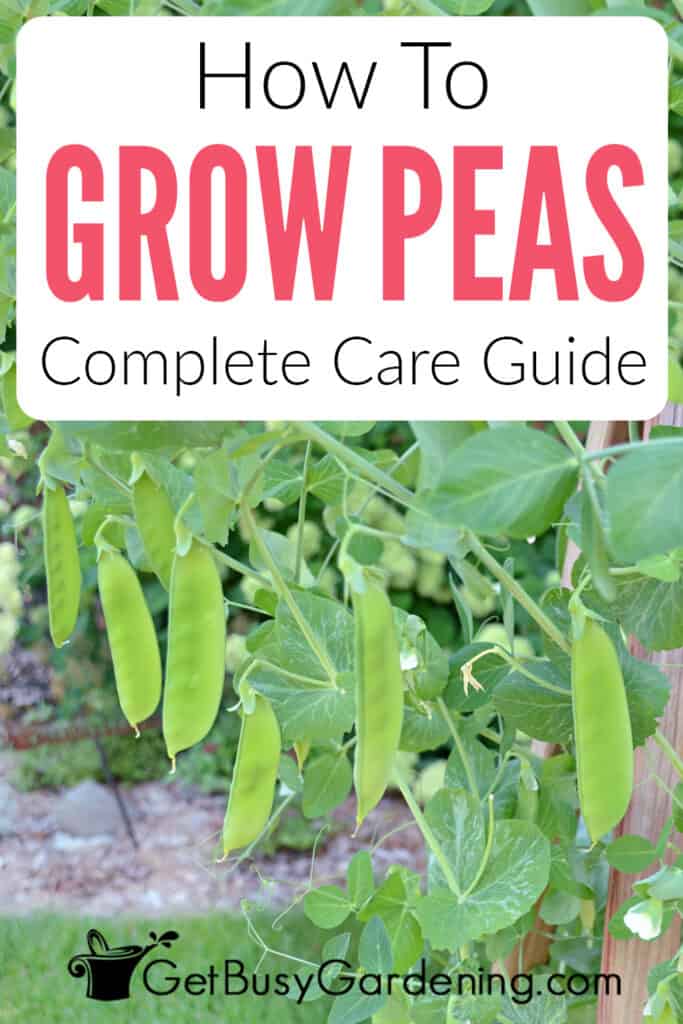Growing peas in your home garden is an easy way to enjoy fresh produce earlier than most other vegetables.
However, to enjoy thriving, productive plants, it’s important to first learn how to care for them correctly.
This detailed guide to growing peas is a walkthrough for gardeners of all skill levels. Learn their sun, soil, and water requirements, plus get tips on pests, harvesting, and much more.
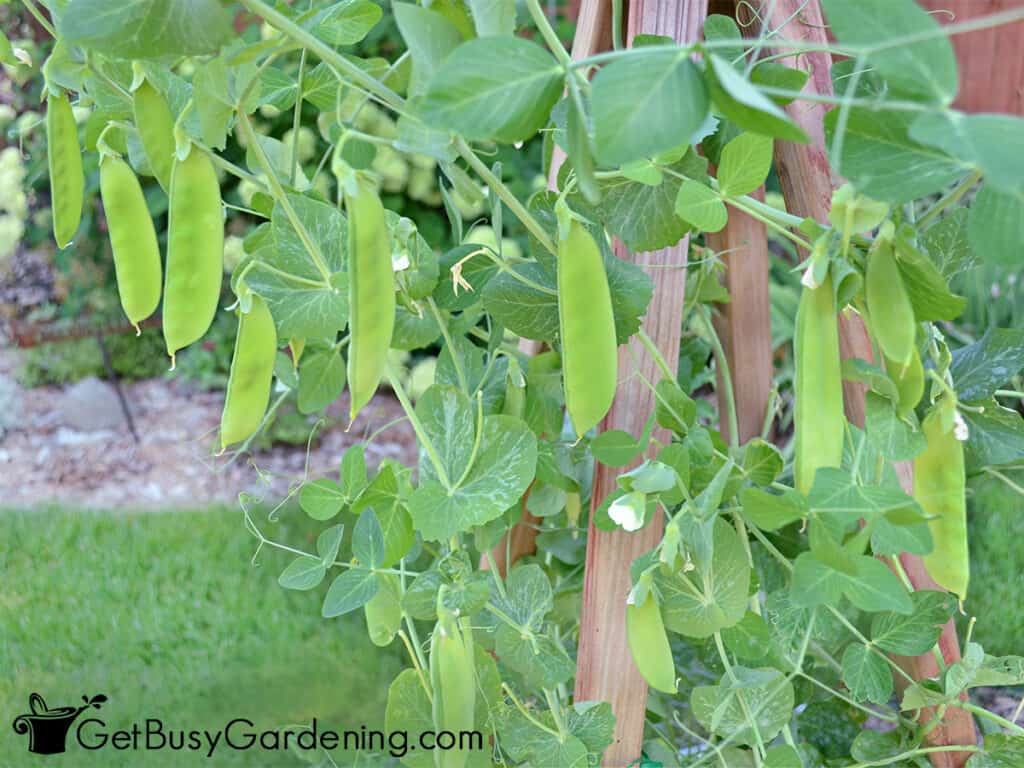

Quick Pea Plant Care Overview
| Scientific name: | Pisum sativum |
| Classification: | Vegetable |
| Common names: | English peas, shelling peas, snow peas, snap peas |
| Hardiness: | Annual |
| Temperature: | 40-85°F (4.4-29.4°C) |
| Flowers: | White, pink, purple, early spring |
| Light: | Full sun to part shade |
| Water: | Keep soil evenly moist, don’t overwater |
| Humidity: | Average |
| Fertilizer: | Balanced vegetable fertilizer, early spring |
| Soil: | Rich, fertile, well-draining |
| Common pests: | Slugs, snails, aphids, flea beetles |
Information About Peas
Peas (Pisum sativum) are the edible seeds of a type of vegetable plant that produces a pod. They’re legumes that are native to the Middle East, and are now grown worldwide.
They’re cold-hardy annuals, and the size of the plants can range anywhere between 1’ tall bushes to 9’ long vines.
Pea plants produce small white, pink, or purple flowers that form pods when pollinated. They’re an easy-to-grow, low-maintenance crop that will continue to produce until the summer heat kicks in.
Different Types
There are 3 main types of Pisum sativum: shelling, snow, and snap peas. Within each of these types there are also two different growth habits – bush and vining.
Bush hybrids are compact and ideal for small spaces or containers. Vining plants climb and require the support of a trellis as they grow.
- Shelling – These varieties, like Wando, Green Arrow, or Lincoln have inedible pods, and you need to remove the peas and cook them before you can eat them.
- Snow – This one has thin pods with tiny peas inside, and you can eat them raw without cooking or shelling. Common varieties include Dwarf Grey, Snowbird and Oregon Giant.
- Snap – The edible pods on this type are crisp and contain large, sweet peas that don’t require cooking. Try Sugar Snap, Early Snap, or Super Daddy.
How Do Peas Grow?
Individual pea pods grow from self-pollinating flowers that typically start opening about 4-6 weeks into their life cycle.
Insects, wind, or even a gentle sweep of your finger will pollinate the flowers. After successful pollination, a pod will begin to develop, and it takes only about three weeks until they’re ready to harvest.
The plant will continue blooming, even as it sets pods. Pick the mature ones regularly to encourage the plant to continue producing more.
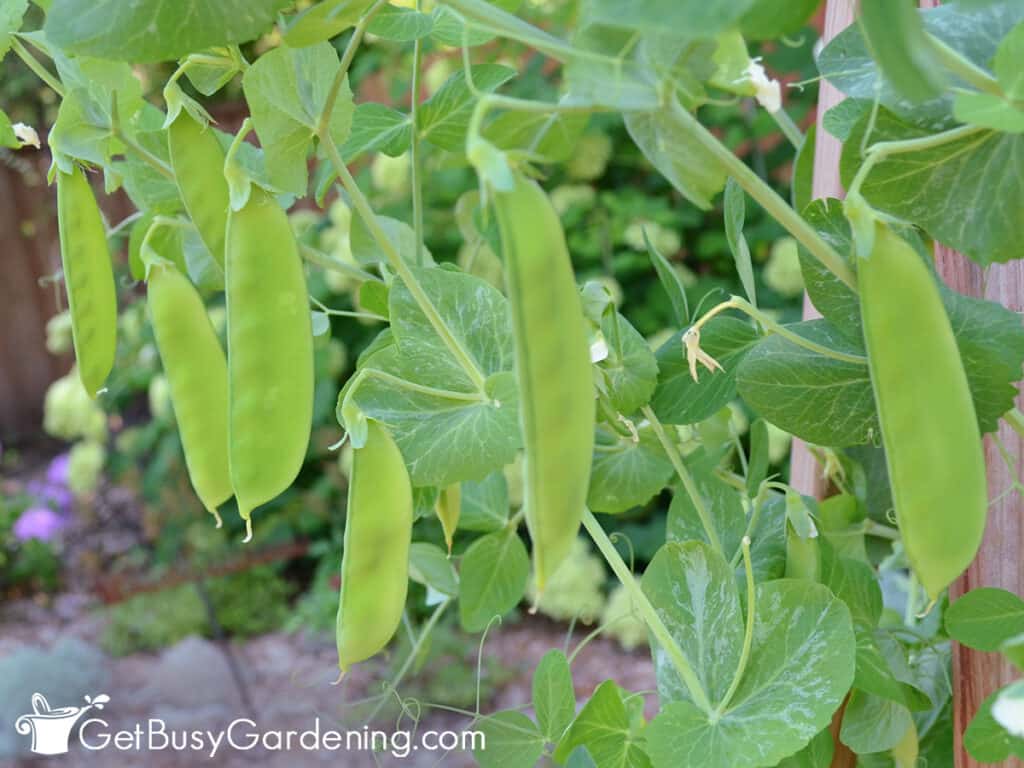
How To Grow Peas
The first step in growing peas is choosing the best place and time to plant them. My tips below will help you get it right and find the perfect spot.
Where To Grow Peas
The type of pea you want to grow will determine how you choose a location. Bush varieties are great for containers or other small spaces, while vining types require more room to spread out, and a support or structure to climb.
Both will thrive best in the full sun with fertile soil that has good drainage, which makes raised beds a popular option.
When To Plant
You should plant your peas as soon as the ground in your garden is workable in late winter or very early spring, because they like the cold.
The best time is 4-6 weeks before your average last frost date. The ground temperature should be around 60°F, which you can check with a soil thermometer probe.
You can plant them in the autumn if you live somewhere with mild winters. Either way, the root system is shallow, and doesn’t like to be disturbed, so it’s best to sow the seeds directly.
Related Post: How To Save Pea Seeds From Your Garden
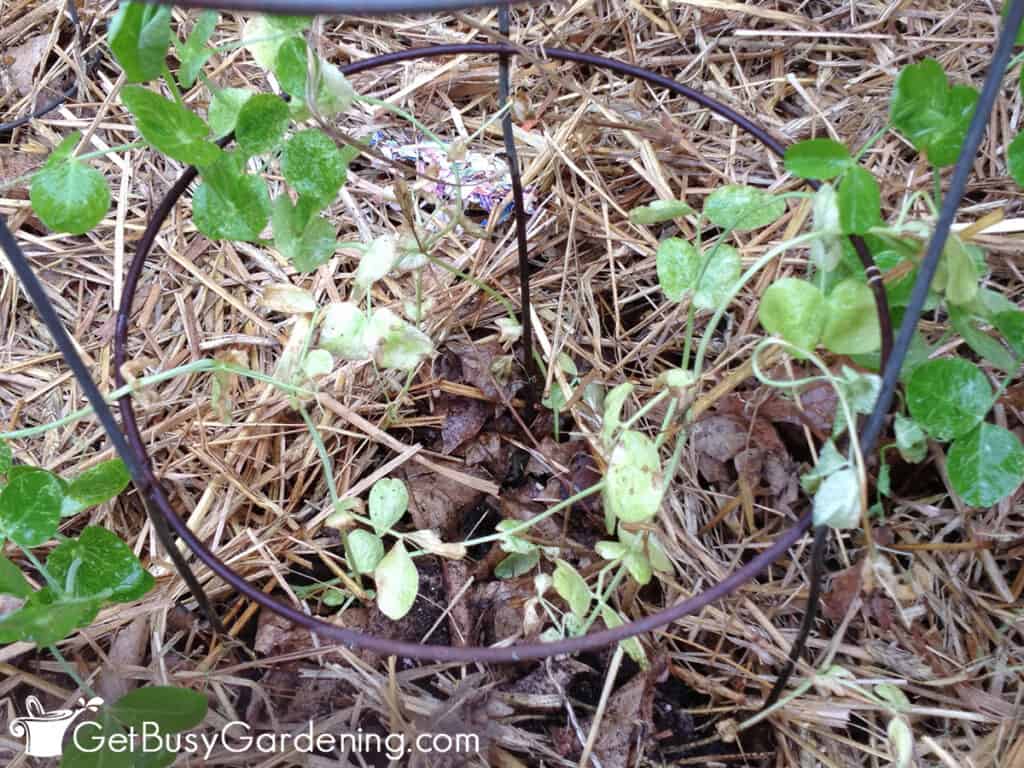
Pea Plant Care & Growing Instructions
Now that you know where and when to grow your peas, it’s time to talk about how to care for them. Create their ideal environment to enjoy a flourishing, low-maintenance plant.
Sunlight
Peas prefer full-sun for 6-8 hours a day. Partial shade is okay, but too little light will lead to a less productive plant, and peas that aren’t as sweet.
Full sun can cause wilting if temperatures climb above 85°F (29.4°F), however. Use a shade cloth in the afternoon to protect them from the most intense sunlight.
Water
Water your peas when the top 1-2” of soil is dry. They like consistent moisture, but will develop root rot and mildew if they get too much. A moisture gauge probe is helpful for getting the amount just right.
Irrigate at the base of the plant to prevent water and soil from splashing on the leaves, which can lead to diseases and mold.
Temperature
The ideal temperature range for growing peas is between 40-80°F (4.4-29.4°C). They can survive down to 20°F (-6.6°C) for a short while, but it can inhibit pod formation.
High heat leads to wilting foliage, and prevents flowering or pod production. When temperatures rise above 85°F (29.4°C), the plant will stop growing and eventually die.
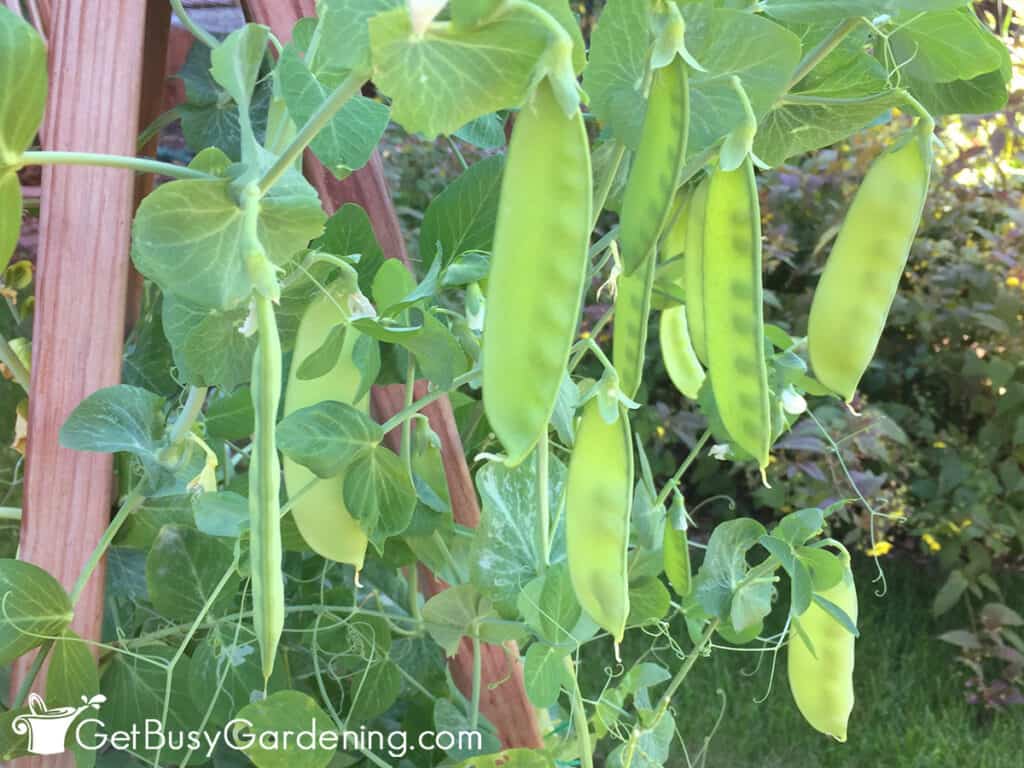
Fertilizer
Peas don’t need fertilizer, as long as the soil is healthy. Amend your beds with compost to enrich it, if needed.
You can also feed them once about 6 weeks after planting with a balanced organic option, like fish emulsion or compost tea, or apply a diluted flowering liquid fertilizer.
Soil
The best soil for peas is rich, fertile, and well-draining, with a pH between 6 and 7.5. You can use a pH probe to check it.
They don’t like soggy soil, so amend your garden with plenty of compost to help improve drainage and nutrient levels.
For containerized plants, start with a good-quality general-purpose potting soil and mix in a few handfuls of perlite.
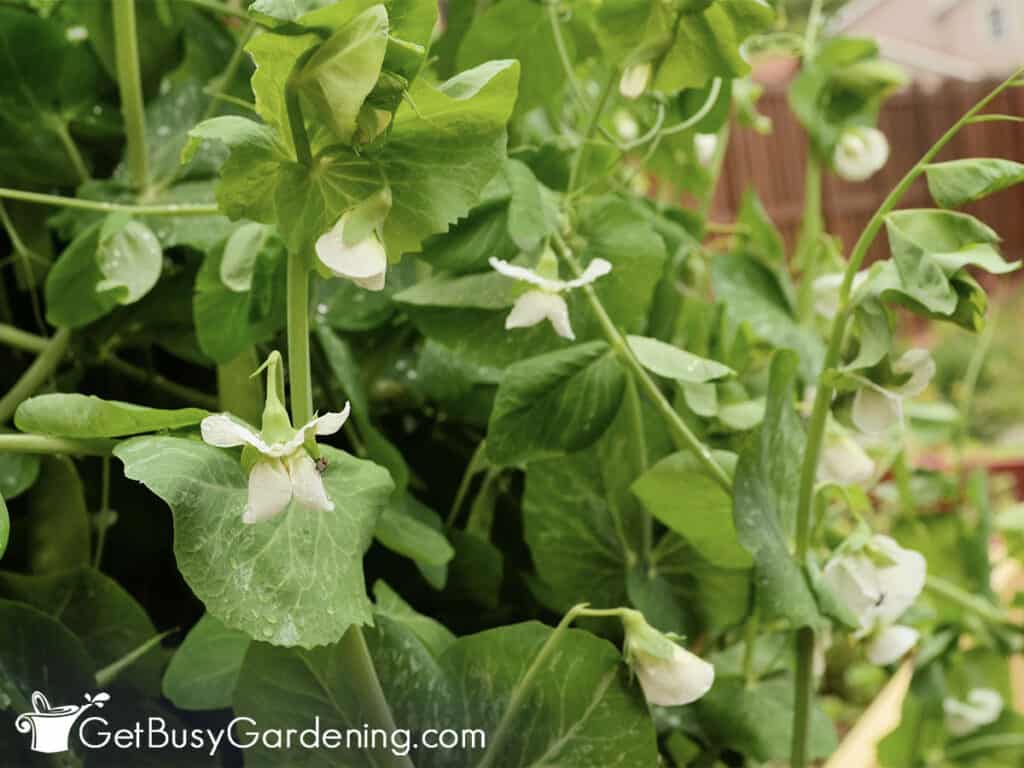
Trellising
Learning how to trellis peas is essential if you’re growing a vining variety. You can use many structures, like a-frames, lean-tos, or cages.
What you choose depends on the size of your plant, so check the tag to see how large it can get. Bush varieties do not need a structure to climb.
Pruning
You don’t need to prune peas regularly, but trimming vining plants when they reach the top of their trellis is useful to control the size.
Use clean, sharp, precision pruners to snip back the vine above a leaf joint. That will encourage more side shoots and pods.
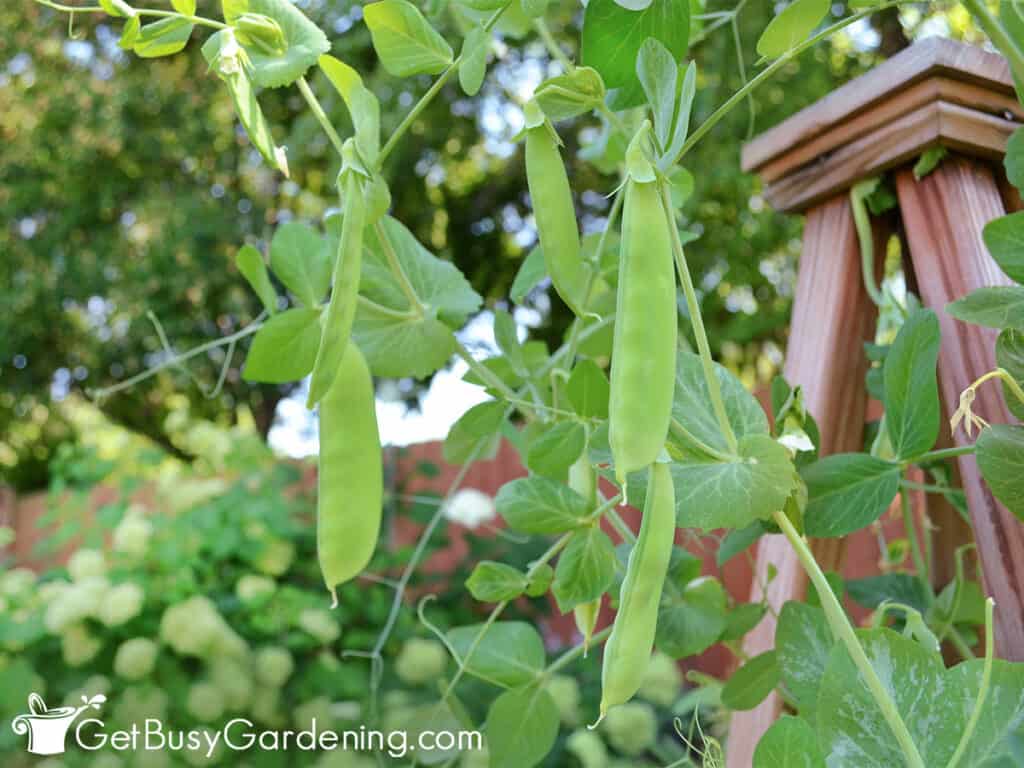
Pest Control Tips
Since peas grow best in the colder months, insects are usually not a huge issue. But flea beetles, snails, slugs, and aphids can occasionally feast on your plants.
Keep the base clean of debris and apply organic bait pellets to help stop ground-dwelling pests. Control the leaf-eaters with a sharp blast of water or an insecticidal soap.
Disease Control Tips
Peas are resistant to many diseases, but they can be affected by Furisurium wilt, mildew, and mold. Look for wilting, yellowing leaves or white, black, or gray growth on the underside of the leaves.
Water at the base of the plant to reduce the risk of soil splashing up or moisture sitting on the leaves, which can spread diseases. You can trim away heavily affected foliage, and use an organic fungicide to prevent or slow the spread.
Related Post: How To Freeze Peas
Tips For Harvesting Peas
Peas will be ready to harvest about 60-70 days after planting. Snap and shelling varieties will have plump, firm, bright pods, but they shouldn’t be hard. Snow varieties are ready when you see that the small peas have formed inside the pods.
It’s best to use snips to cut them off rather than pulling them, or you could accidentally damage the vine. Once they start producing, check back daily because they grow quickly.
Related Post: How To Can Peas

Troubleshooting Common Problems
Growing peas is easy, but no plant is ever problem-free. If you run into one of these more common issues, use my tips in this section to help get your plant back into good health.
Yellow Leaves
Overwatering and disease can cause yellowing pea foliage, but it also naturally occurs at the end of the plant’s life cycle.
Keep the soil moist but not puddled or wet, and water at the bottom to reduce the risk of diseases.
When temperatures begin to warm up, the leaves will start yellowing. This is simply the plant putting the last of its energy into producing pods instead of foliage as it comes to the end of its growing season.
Brown Leaves
Root rot, lack of nutrients, age, improper watering, and heat are also a common cause of brown leaves.
Keep the soil evenly moist, but never wet or soggy, and add fertilizer if necessary. If it’s getting hotter outside, the plant is probably naturally beginning to die off.
Plant Wilting
High heat, lack of water, and Furisurium wilt are all potential causes of a wilting pea plant.
Use shade cloth to protect plants in the afternoon when it gets above 85°F (29.4°C), and keep the soil evenly moist. If those don’t help, you can try using an organic fungicide to slow or stop the spread of disease.
No Flowers Or Pods
A lack of blossoms or pod development is a sign that something is wrong with the environment. Temperature extremes, lack of water, and nutrient deficiency are the main problems.
It needs to be above 40°F (4.4°C) and below 85°F (29.4°C), anything outside this range will temporarily stall flowering and pod formation.
Make sure the soil never becomes bone dry, especially when your plants are producing. If nothing else is helping, try adding a balanced vegetable or flowering plant food to boost nutrition.

FAQs
No, pea plants are not hard to grow. They do best in cool weather, don’t require fertilizer, and will thrive as long as they have full sun, consistent water, and nutrient-rich soil.
No, pea plants do not produce all summer, they will stop once the temps get too hot. Anything above 85°F (29.4°F) will prevent flower and pod formation, and eventually kill the plant.
The secret to growing peas is getting the timing right. They don’t like the heat, so you should plant them as soon as the ground thaws in early spring.
Peas take 60-70 days to grow from seed to harvest, but the exact range can vary depending on the environment, and specific variety that you have.
Pea plants are annuals that last only one season. When summer temperatures get consistently above 85°F (29.4°C), they stop producing and start to die off.

If you’d like to learn how to make the most of your space and get as much homegrown food as possible, then my Vertical Vegetables book is perfect! It will teach you all you need to know, has tons of gorgeous photos, and includes 23 DIY projects you can build for your own garden. Order your copy today!
Learn more about my Vertical Vegetables book here.
More About Vegetable Gardening
Share your tips for growing peas in the comments section below.

